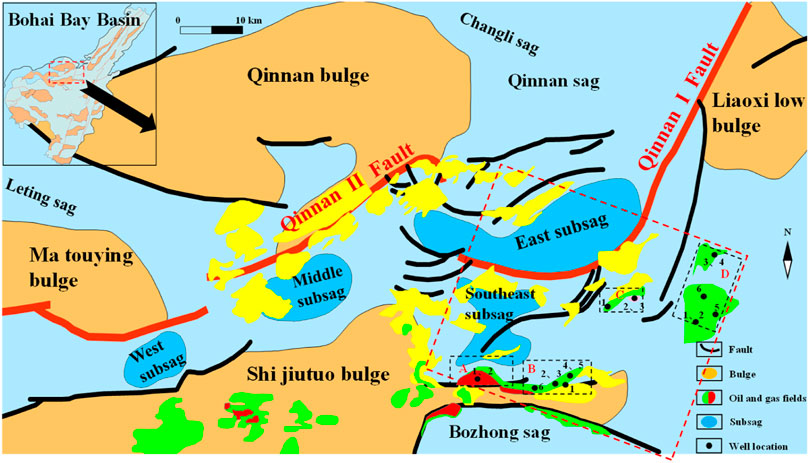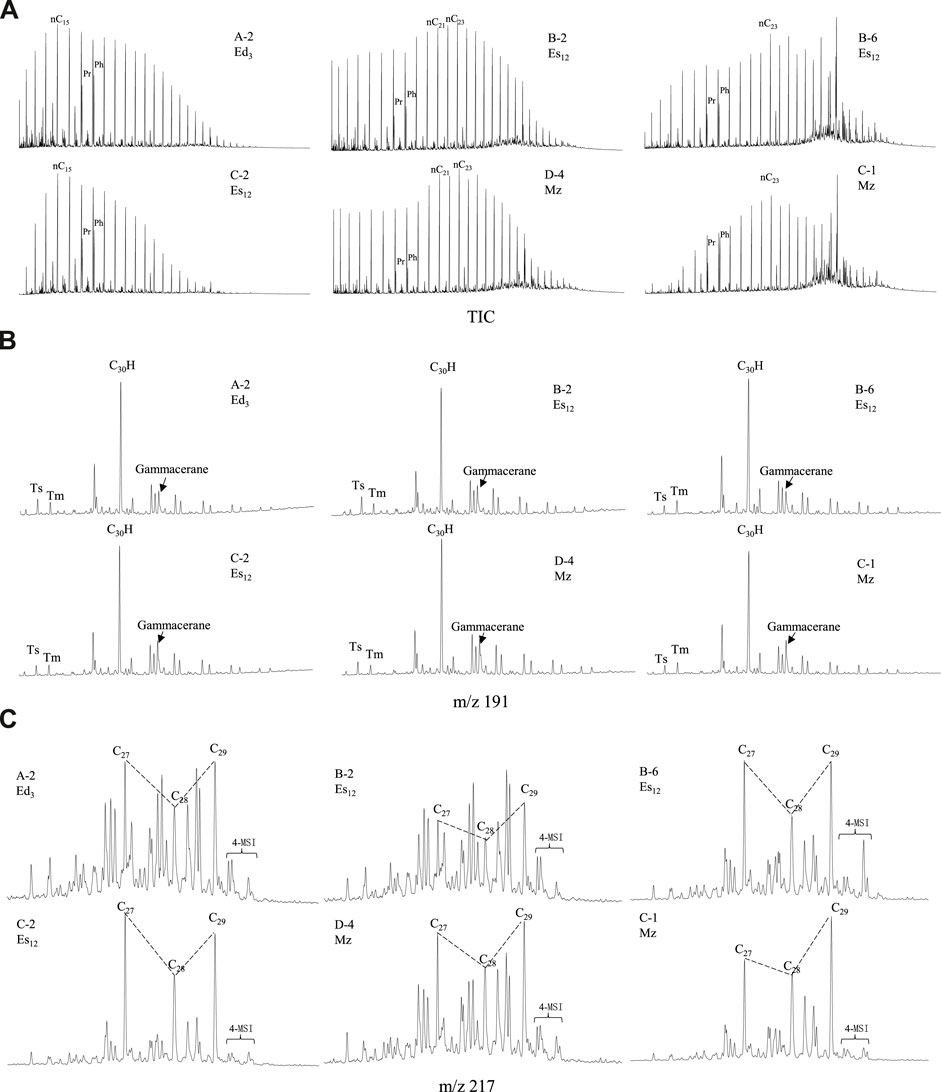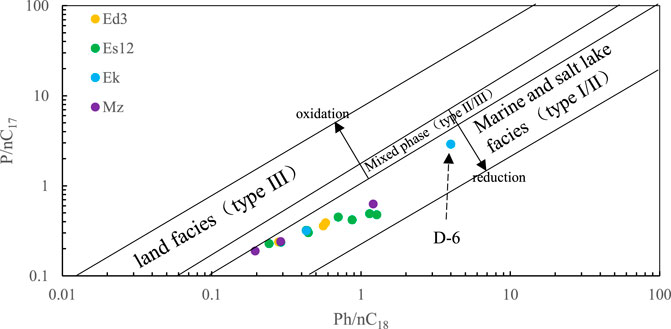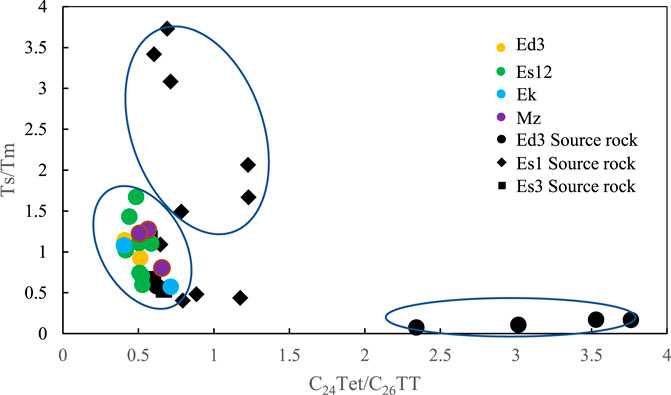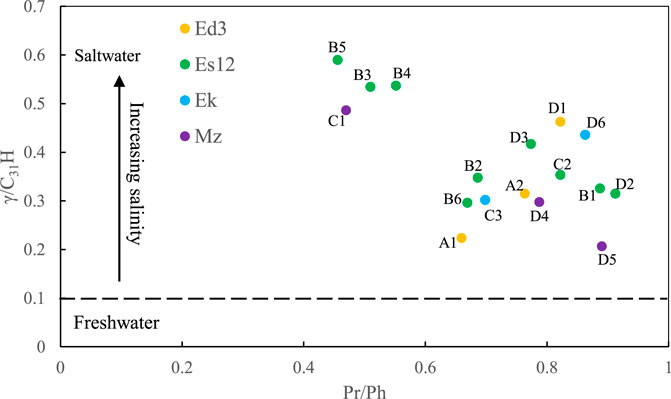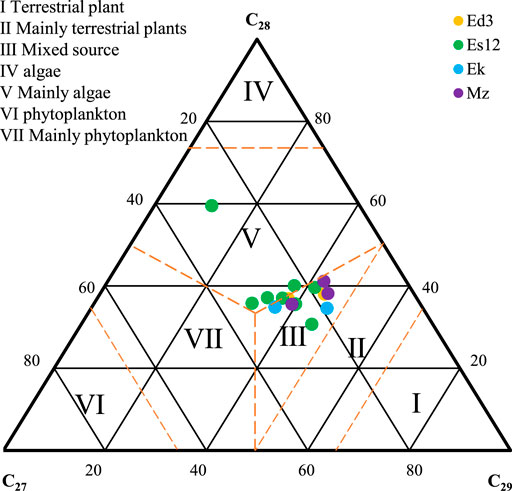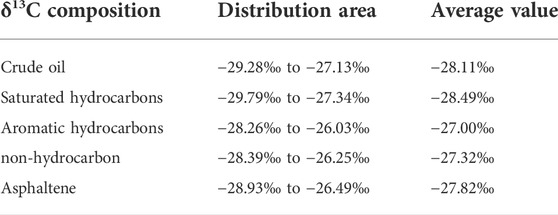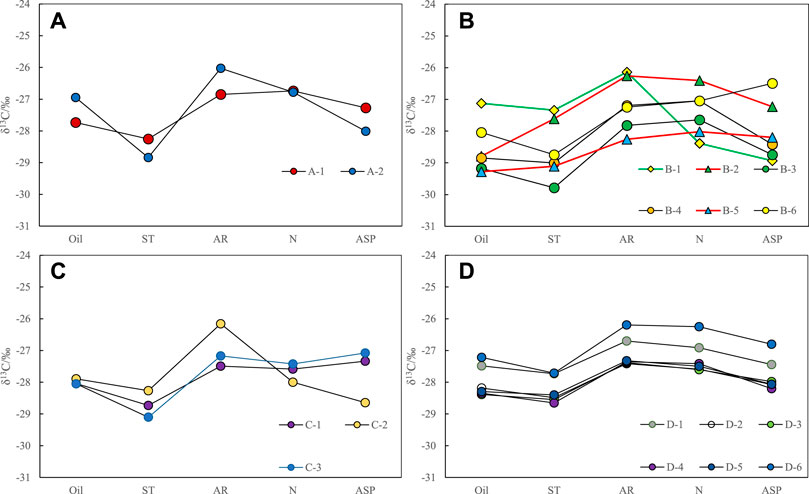- 1Hubei Key Laboratory of Petroleum and Environmental Geochemistry, School of Resources and Environment, Yangtze University, Wuhan, China
- 2CNOOC China Limited, Tianjin Branch, Tianjin, China
The oil and gas exploration degree of Qinnan sag is low. In this paper, all the 17 crude oil samples from the four reservoirs in the eastern Qinnan sag were taken as the research object. Research methods include GC-MS, stable carbon isotopic of crude oil and group components and other analytical methods. The geochemical characteristics of crude oil were studied by the main parameters, Pr/ph, γ/C31 hopane, Ts/Tm, 4MSI and C29 sterane isomerization. The results show that most of the hydrocarbon generating parent materials of all the 17 crude oils are reductive lacustrine sedimentary organic matter with higher salinity. The crude oil of Es12 is mainly derived from low aquatic algae, and the crude oil of Ed3, Ek and Mz shows the characteristics of a mixed source. The maturation characteristics of crude oils are low mature-mature. The stable carbon isotope of oil and the components is in the range of −30‰ to −26‰, which shows the distribution characteristics of δ13CST <δ13CASP <δ13CNOS <δ13CAR. The characteristics in B-6, C-1 and C-3 of crude oils show the heavy δ13CASP and high abundance of hopane, indicating that there is more contribution from bacterial sources. The crude oil from Es12 is mainly the contribution of Es1 source rocks. The crude oil of Mz, Ek and Ed3 is mainly the mixed source of Es1 and Es3 source rocks, and Es3 is the main source, and the oil source may mainly come from the southeast subsag. The carbon isotope of the component in Block D can be divided into two kinds of crude oil, which may contribute to the oil source of the Bozhong sag. The eastern of Qinnan sag has great hydrocarbon potential.
Introduction
The Qinnan Sag is located northwest of the Bohai Sea, with a low degree of exploration and huge potential for oil and gas exploration. Since the discovery of the QHD29-2/E oilfield in the Southeast sub-sag in 2009, there has been no major exploration breakthrough. The predecessors have systematically studied the geological conditions of hydrocarbon accumulation in the region. From the current knowledge, the Paleogene source rocks in the Qinnan Sag include the Paleogene Sha three Member (Es3), Sha one Member (Es1) and Dong three Member (Ed3). There are good-quality source rocks in each member, especially in the Southeast subsag where high-quality Es3 and Es1 source rocks are developed, and some of them have reached the mature stage and have the material basis for the formation of large oil and gas fields. For example, Yang et al. (2019) believed that the Es3 source rocks had higher organic matter abundance overall, and the source rocks in the Southeast Sag had the highest organic carbon content, followed by the East Sag and the West Sag. Regarding the source of oil and gas, Niu et al. (2018) discussed the reasons for the distribution of extra-heavy oil, light oil, condensate oil and heavy oil in the QHD29-2 oilfield from the perspective of evaporative fractionation and biodegradation. Zhuang et al. (2011) concluded that the oil and gas in the QHD29-2 oilfield were mixed sources of Es1 and Es3 source rocks, and the non-hydrocarbon natural gas (CO2) was inorganic mantle-derived gas from natural gas composition and isotopic analysis combined with fluid inclusion analysis. Samra et al. (2022) studied the source and deposition environment of the samples by parameters such as Pr/Ph, Pr/nC17, Ph/nC18, C31/C19 and so on. Nazir et al. (2020) use biomarker compounds to predict the source of organic matter, sedimentary environment and lithology. Wang et al. (2015) analyzed the crude oil geochemical properties and thermal maturity of the QHD29-2 oilfield, and using ten parameters proposed by Hao et al. (2009), such as C19/C23, C20/C23, C23/H, C24/C26, S/H, 4MSI, C35/C34, G/H, ETR and C27/C29, were analyzed by Hierarchical Cluster Analysis (HCA) to analyze the oil source of the crude oil in QHD29-2 oilfield. Relatively speaking, previous studies on the geochemical characteristics of crude oil in other oil reservoirs in the eastern Qinnan Sag are relatively few. Based on previous studies, this paper further samples crude oil from four major oil reservoirs in the eastern Qinnan sag. Through comparative analysis, the differences in the geochemical characteristics of crude oil in each reservoir are pointed out, which is helpful for a more reasonable understanding of the formation of oil and gas resources in the entire Qinnan sag Distribution characteristics are important.
Geological overview
The Qinnan Sag is located northwest of the Bohai Sea. It is a faulted depression surrounded by four peripheral uplifts, namely Qinnan Uplift, Matouying Uplift, Shijiutuo Uplift, and Liaoxi Low Uplift, with an area of about 2,300 km2. The sag is nearly east-west, controlled by the Qinnan I and II faults, and is divided into four sub-sags: the West Sag, the Middle Sag, the East Sag, and the Southeast Sag (Shi et al., 2014). Overall, it shows the characteristics of deep in the east and shallow in the west, big in the east and small in the west, new in the east and old in the west. The sag deposited the Mesozoic (Mz) on the Archaean granite basement, and deposited the Kongdian Formation (Ek), Shahejie Formation (Es) and Dongying Formation (Ed) in the Paleogene in the rifting period, mainly delta and lacustrine facies, in the Neogene in the depression stage, the Guantao Formation (Ng), Minghuazhen Formation (Nm) and other strata were deposited, mainly fluvial facies (Shi et al., 2014; Zhao et al., 2021; Sun et al., 2022).
During the depositional period of Es3, Ed3 and Ed2, the fault activity was strong, and they were the main source rocks and caprock development period. The stronger the fault activity, the thicker the source rock and the higher the maturity; from Es12 and Ed1 to the present sedimentary period, the fault activity is weak, which is the main reservoir development period, and the reservoirs in the position with weak fault activity and the adjustment zone are more developed. The position of weak fault activity is easy to form lithological traps; the position of strong fault activity is easy to form fault-lithological traps. The vertical strong and weak evolution of faults in the Paleogene provided high-quality source rocks and reservoir and caprock conditions for hydrocarbon accumulation.
So far, oil and gas fields A and B have been discovered at the 426 subsidence on the south side of the Southeast Sag, and oil fields C and D have been discovered in the fault terrace area on the east side of the Southeast Sag.
Samples and experimental methods
This time, a total of 17 crude oil samples were collected from four oil reservoirs on the east side of the Qinnan Sag. The distribution of sample wells is shown in Figure 1. Among the 17 crude oil samples, there are two oil samples from reservoir A (two samples of Ed3), six samples from reservoir B (six samples of Es12), three samples from reservoir C (one sample of Es12, one sample of Ek, one sample of Mz), and six samples from reservoir D (one sample of Ed3, two samples of Es12, one sample of Ek, two samples of Mz), of which the D-6 sample is a high water content oil sample.
All experiments were completed in the Hubei Provincial Key Laboratory of Oil and Gas Geochemistry and Environment. First, take about 20 mg of crude oil sample, add n-hexane and let stand for 12 h to precipitate asphaltenes. After filtering asphaltenes, the filtrate is separated by a solid-phase chromatography column filled with silica gel and alumina, followed by adding n-hexane, n-hexane+ Dichloromethane mixed solvent (volume ratio of 2:1) and a mixed solvent of dichloromethane + methanol (volume ratio of 93:7) were used to separate saturated hydrocarbons, aromatic hydrocarbons and non-hydrocarbon components, respectively. The separated saturated hydrocarbons were tested by gas chromatography-mass spectrometry, and the instrument model was Agilent 7890B-5977B. The chromatographic column used HP-5MS quartz elastic capillary column (30 m × 0.25 mm × 0.25 μm). The temperature of the injector was 300°C, the carrier gas was pure He, and the flow rate was 1 ml/min. The heating program was as follows: the initial temperature was 50°C, after a constant temperature of 2 min, the temperature was increased to 310°C at a rate of 3°C·min-1, and the constant temperature was maintained for 18 min, EI ionization mode, ionization energy 70 eV, atomic mass full scan range 50–550 amu. The isolated group components and the whole oil were subjected to carbon isotope detection by IsoPrime isotope mass spectrometer from GV Instruments, United Kingdom.
Crude oil geochemical characteristics
Through the GC-MS detection of saturated hydrocarbons in all of the 17 crude oil samples, it can be seen from the total ion chromatogram (TIC) analysis that the crude oil samples of this batch can be divided into three categories according to the peak shape: front peak type, back peak type The peak patterns and homohopane abundance patterns are shown in Figure 2.
N-alkanes and isoprenoid alkanes.
The pristane/phytan (Pr/Ph) ratio is one of the good parameters indicating the type of source rock parent material and depositional environment (Tian et al., 2018). In the sediments of strongly reducing and high salinity environments, phytanes tend to have an absolute dominance and high abundance; in the oxidative environments of swamps, pristane often has a strong dominance (Yang and Zhang, 2005). Didyk et al. (1978) considered that Pr/Ph <1.0 is a reducing environment, and Pr/Ph >1.0 is an oxidizing environment. Peters et al. (2005) and others further pointed out that Pr/Ph >3.0 represents the input of terrigenous organic matter in an oxidative environment, and Pr/Ph <0.8 represents an anoxic and reducing depositional environment. The Pr/Ph of the samples in this paper is all less than 1 (Table 1). Among them, the range of Ed3 value is 0.66–0.82, with an average of 0.75; the range of Es12 value is 0.46–0.91, with an average of 0.70; the range of Ek value is 0.70–0.86, with an average of 0.78; the range of Mz value is 0.47–0.89, with an average of 0.72, indicating that the crude oil parent materials were all formed in a relatively reduced lacustrine sedimentary environment.
Isoprenoids are used both to indicate the depositional environment and to reflect the source of organic matter (Xie et al., 2017). Pr/nC17 and Ph/nC18 are often used to study the type of hydrocarbon parent material, source rock depositional environment and crude oil maturity (Tian et al., 2018). The Pr/nC17 value of the crude oil samples from Ed3 of the Qinnan Sag is 0.24–0.39, with an average value of 0.33, and the Ph/nC18 value is 0.28–0.58, with an average value of 0.47; The Pr/nC17 value of Es12 crude oil sample is 0.23–0.49, the average value is 0.36, the Ph/nC18 value is 0.24–1.28, the average value is 0.65; The Pr/nC17 value of Ek crude oil sample is 0.32–2.90, the average value is 1.61, the Ph/nC18 value is 0.43–4.00, the average value is 2.21; The Pr/nC17 value of Mz crude oil sample is 0.19–0.63, the average value is 0.35, the Ph/nC18 value is 0.20–1.21, the average value is 0.57. From the intersection diagram of Pr/nC17 and Ph/nC18 (Figure 3), it can be seen that the crude oil of Ed3, Es12, Ek and Mz all fell into the marine and salt lake sedimentary areas, reflecting the organic. The parent material is mainly contributed by algae and lower aquatic organisms. Among them, the D-6 sample shows an abnormality that deviates significantly from other oil samples, which may be caused by the high water content of the oil samples.
Terpenoids
Terpenes are widely present in biomarker compounds, among which tricyclic terpenes have strong characteristics and are often used to identify the source of organic matter, while tetracyclic terpenes have a good relationship with the input of terrestrial organic matter (Jin et al., 2019). The content of tricyclic terpenes (TT) and tetracyclic terpenes (Tet) can reflect the oil parent material (Huang et al., 2020), C19 tricyclic terpenes/C23 tricyclic terpenes (C19TT/C23TT) and C24 tetracyclic terpenes/The ratio of C26 tricyclic terpenes (C24Tet/C26TT) is also regarded as an important indicator of terrigenous organic matter input. The higher the ratio, the greater the contribution of terrestrial organic matter (Chen, 2012).
The ratio of Ts/Tm is generally used to assist in judging the maturity of crude oil (Peters and Moldowan, 1993). It is generally believed that with the increase of thermal evolution degree, Tm will transform to Ts, and Ts/Tm will increase (Li et al., 2018). The Ts/Tm values of Ed3 of Qinnan Crude Oil are 0.93–1.14, with an average value of 1.05; the Ts/Tm values of Es12 are 0.6–1.68, with an average value of 1.08; the Ts/Tm values of Ek are 0.58–1.08, with an average value of 1.08.0.83; Mz Ts/Tm values range from 0.81 to 1.28, with an average value of 1.11. Figure 4 comprehensively reflects the high maturity of crude oil samples in this area. The terpene parameters of each oil sample are relatively concentrated, and the C24Tet/C26TT contributed by higher plants is relatively low, which is quite different from that of Ed3, which is also consistent with the immature geological background of the source rocks of Ed3.
Gammacerane is a pentacyclic triterpenoid, mainly derived from tetrahymenin of protozoa and photosynthetic bacteria. It is formed by reduction. The enrichment of gamma wax is often related to the sedimentary environment. The high content of gamma wax indicates the sedimentary environment with strong reduction and high salinity, and when the ratio is greater than 0.2, it is a brackish or saline environment, and can be used as a sign of water stratification. In the crude oil samples, the ratio of gammacerane/C31 hopane ranged from 0.21 to 0.59, with an average value of 0.38, indicating that the original organic matter was a lacustrine depositional environment between brackish water and saltwater (Figure 5).
Sterane compounds
Steroids are tetracyclic compounds with alkyl side chains. Conventional steranes have a carbon number of C27–C29, but they also have extremely complex carbon number changes (Zhang et al., 2022). It is generally believed that C27 steranes are mainly derived from lower aquatic organisms and algae, and C29 steranes are mainly derived from terrestrial higher plants, but there are also cases of C29 sterane parent sources such as diatoms and brown algae (Zhou and Zhang, 2021). The steranes do not undergo mutual transformation after being formed, so they can be used as important compounds for analyzing the source of organic matter. C27, C28, and C29 regular steranes can be used to determine the biogenesis of organic matter. It is generally believed that organic matter derived from lower organisms algae has the dominant characteristics of C27 steranes, and organic matter derived from higher plants has the dominant characteristics of C29 steranes. When both are high, it indicates that there is a dual contribution from the mixed source of higher plants and lower aquatic organisms (Bao et al., 2006). The C27, C28, and C29 regular steranes of 17 pieces of crude oil (Figure 6) show that the crude oil in Es12 is mainly derived from algae, and the rest of the layers contribute to mixed biogenesis.
C29 sterane isomerization parameters C29-ααα20S/(20S+20R) and C29ββ/(ββ+αα) are commonly used maturity indicators, the biological configuration R is transformed into the geological configuration S, which is manifested as an increase in the ratio (Li et al., 2018; Zhou et al., 2021). Figure 7 shows the cross plot of the ratios of C29-ααα20S/(20S+20R) and C29ββ/(ββ+αα) for all the 17 crude oil samples. From this, it can be seen that the crude oil of Ed3 and Mz have relatively high maturity, and the crude oil of Es12 has a great change in maturity, ranging from low maturity to mature. The low maturity crude oil is mainly B5, D4, C3, and C2, Mature crude oil is mainly distributed in A and D oil fields.
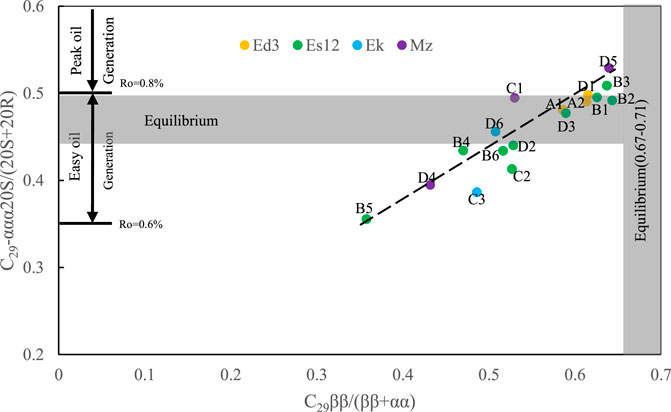
FIGURE 7. Correlation between C29-ααα20S/(20S+20R) and C29ββ/(ββ+αα) sterane of crude oil in Qinnan sag.
C304-methylesterase (4MSI) is generally derived from 4α-methyl sterol in dinoflagellate organisms and can also be produced by some bacteria. The 4-methyl sterane in freshwater lakes is mainly the biogenic source of dinoflagellates, while the fossils of dinoflagellates containing 4-methyl sterane in the marine and saline lake environments are rare. The enzymatic reduction products became the main source of 4MIS in marine and saline lake environments. The 4MSI content of crude oil formed in a high salinity environment is lower than that of crude oil formed in a fresh or brackish water environment (Bao et al., 2007; Zan et al., 2012; Chen et al., 2016; Bo, 2018).
4MSI, as an important biogenesis index in southern Qinan, can better distinguish crude oil source information. By comparing the characteristics of Qinnan crude oil and source rocks by 4MSI and γ/C30 hopane index, it can be seen from Figure 8 that Es12 of the crude oil samples analyzed in this paper are mainly contributed by Es1 source rocks, and the rest of the layers exist Contribution of mixed source rocks of Es1 and Es3 source rocks.
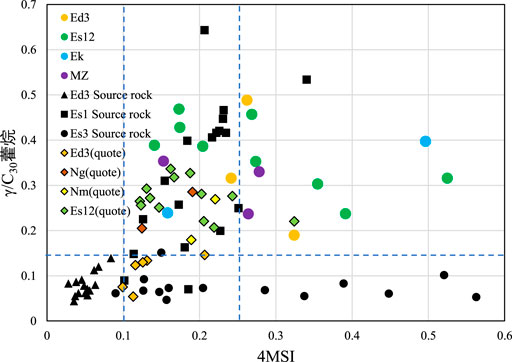
FIGURE 8. Correlation between 4MSI and γ/C30 hopane of crude oil in Qinnan sag; quote date from Wang et al. (2015).
Component carbon isotopes
It is generally believed that the carbon isotope of organic matter in sedimentary rocks mainly depends on the carbon isotopic composition of its precursors. The carbon isotopic composition of organic matter in terrigenous higher plants is heavier, generally greater than −26.0‰ (Chen et al., 2010). Generally speaking, with the increase of the polarity of saturated hydrocarbons, aromatic hydrocarbons, non-hydrocarbons and asphaltene chemical groups in sedimentary organic matter, its carbon isotope δ13C value will gradually become heavier, that is, δ13C saturated hydrocarbons < δ13C aromatic hydrocarbons < δ13C non-hydrocarbons <δ13C asphaltenes.
Table 2 shows the distribution range of δ13C crude oil value, saturated hydrocarbon, aromatic hydrocarbon, non-hydrocarbon and asphaltene in the Qinnan area. As a whole, there is a “reversal” phenomenon of δ13C saturated hydrocarbons < δ13C asphaltenes < δ13C non-hydrocarbons < δ13C aromatic hydrocarbons (Wan et al., 2020; Wang et al., 2020) (Figure 9), which all reflect the high contribution of algae and other lower aquatic organisms to hydrocarbon generation.
By analyzing the stable carbon isotope composition of crude oil family components by the reservoir, it can be seen that the carbon isotope values of each sample in reservoirs A, B, and C are quite different (Figure 9), while reservoir D shows highly consistent characteristics of the two types of crude oil. The specific performance is that the difference between the saturated hydrocarbons and aromatic hydrocarbons of the A-2 sample is the largest, reaching 2.81‰, and the maximum difference of the other samples does not exceed 2‰. B-6, C-1, and C-3 show anomalous characteristics of asphaltenes, and their TICs (Figure 2) also show anomalous characteristics of a high abundance of hopanes. The TIC of samples C-1 and C-3 towards other good positions C and D gradually showed the characteristics of a sharp decrease in hopane content, and the normal peak shape changed from the back peak shape to the front peak shape.
Results and discussion
Based on the above analysis, the sedimentary environment, biological origin, maturity and carbon isotopic composition characteristics of the crude oil samples taken this time generally show the following characteristics: Pr/Ph in the crude oil samples are all less than 1, and the γ/C31 hopane ratio is between 0.21 and 0.59, reflecting that the original organic matter is the reduced lacustrine sedimentary organic matter between brackish water and saltwater; Pr/nC17 and Ph/nC18 cross diagram, C19TT/C23TT value, C24Tet/C26TT value and C27, C28, C29 regular sterane are all It reflects that the organic parent material of crude oil is mainly contributed by algae and lower aquatic organisms; Ts/Tm and C29-ααα20S/(20S+20R) and C29ββ/(ββ+αα) parameters show that the crude oil in this area is generally in the low-mature-mature stage, the maturity of Es12 varies widely, and the Ed3 and the Mz have higher maturity.
According to the previous research results (Nazir et al., 2020; Nazir and Fazeelat, 2017a there are obvious differences in the high-quality source rock intervals in the Bohai Bay Basin: The Es1 source rock was formed in a strongly reducing saline lake environment, and the Es3 source rock was formed in a weakly reducing freshwater-brackish water environment, and the Ed3 source rock was partially oxidized, and the contribution of terrigenous organic matter was obvious. In this paper, the information of this batch of oil samples is compared with the analysis of the geochemical characteristics of the previous source rocks. Based on the crude oil maturity information and 4MSI and other parameter characteristics, it can be found that the crude oil in the Mz and Ek has high maturity, medium γ and high 4MSI, mainly due to the mixed source of the Es1 and Es3 source rocks; the oil maturity of the Es12 oil varies greatly, with high γ and low 4MSI, which are mainly self-generated and self-storage, and a small part of the Es3 source rocks cannot be ruled out contribution; the crude oil of the Ed3 has high maturity, medium γ, and low 4MSI, which contributes to the mixed source of the Es1 and Es3 source rocks, and mainly contributes to the migration of the Es3 source rocks with higher maturity; the Ng and the Nm has high γ and low 4MSI, and is mainly contributed by the Es1 source rocks.
The carbon isotopes of the components are generally in the range of −30‰ to −26‰, which comprehensively reflects that the organic matter is mainly contributed by low-level aquatic organisms such as algae to generate hydrocarbons, which is consistent with the biogenic characteristics. Zhang et al. (1992); Fu and Qin, (1995); Chen and Xu, (1992) and other researchers believe that various types of organisms have special chemical compositions, and their carbon isotopic compositions are also different. The average value of δ13C is lower than that of organic matter from higher plants. If there is more input of higher plants in the parent source of sedimentary organic matter, δ13C in sedimentary organic matter will often increase, so that the less polar components have relatively heavier carbon. isotopic composition. Meyers and Simoneit, (1999) and other studies have shown that thermal action can also deplete light carbon isotopes in sedimentary organic matter, thereby changing the carbon isotopic composition of sedimentary organic matter, resulting in δ13C saturated hydrocarbons > δ13C aromatic hydrocarbons > δ13C non-hydrocarbons > δ13C asphaltenes. Wang (2000) and others believe that biodegradation can also change the carbon isotopic composition of saturated hydrocarbons, aromatic hydrocarbons, non-hydrocarbons and asphaltenes, and the δ13C saturated hydrocarbon value of crude oil subjected to biodegradation tends to be positive, and the δ13C aromatic hydrocarbon value is almost No change occurred, and the non-hydrocarbon components and asphaltene components tended to be enriched in 12C. If it is thermal action or biodegradation, the δ13C saturated hydrocarbon value will not be lower than the δ13C aromatic hydrocarbon value. Therefore, the carbon isotopic reversal of aromatic components in crude oil is mainly related to the source of organic matter and the depositional environment.
The carbon isotopic composition of crude oil components has the reversal characteristics of δ13C saturated hydrocarbons < δ13C asphaltenes < δ13C non-hydrocarbons < δ13C aromatics. It is speculated that the carbon isotopic reversal of aromatic components in crude oil is mainly related to the source of organic matter and the depositional environment. A-2 sample has the largest difference between saturated hydrocarbons and aromatic hydrocarbons, reaching 2.81‰. B-6, C-1, and C-3 show anomalous characteristics of asphaltene anomalies, and their TICs also show anomalous characteristics of high abundance hopanes. Based on the characteristics of crude oil samples, it is preliminarily speculated that these crude oils have strong bacterial biogenic contributions. The carbon isotopic composition of the D reservoir component can be divided into two categories. The D1 and D6 samples have similar characteristics, and the remaining samples are highly overlapping, indicating that there are two types of crude oil from different sources, and there may be oil source contributions from the Bozhong sag.
Conclusion
1) The Paleogene crude oil on the eastern side of the Qinnan Sag has the characteristics of low Pr/Ph and high γ/C31, reflecting that the brackish water-salt water partially reduces the biogenic organic matter of lacustrine sediments, and the crude oil of the Es12 is mainly derived from algae, and the Ed3, Ek and Mz are mixed biogenic sources. The carbon isotopic composition of crude oil and its components ranges from −30‰ to −26‰, indicating that lower aquatic organisms are the main contribution. Some of the crude oils have obvious bacterial biogenic contributions.
2) Judging from the characteristics of biomarker combinations and differences in maturity, no crude oil contributed by the Dongying Formation source rocks has been found in this area, and the crude oil of the Es12 is mainly contributed by the Es1 and Es3 source rocks. The crude oil in the Mz, Ek and Ed3 is mainly the mixed source of the Es1 and Es3 source rocks. Reservoir D includes two types of crude oil, which may include the contribution of oil sources in the Bozhong sag.
3) Crude oil has been found on the eastern side of Qinnan Sag, mainly located around the Southeast Sag, while the source rocks in the East Sag have a large distribution area, deep depth, high thermal evolution maturity and great hydrocarbon generation potential, but relatively few oil and gas reservoirs have been discovered. It has great potential for oil and gas exploration.
Data availability statement
The raw data supporting the conclusion of this article will be made available by the authors, without undue reservation.
Author contributions
XS: manuscript writing. YL, ZW, XX, and YW: manuscript discussion. DW, FL, FW: assistance in sample collection. ZL: assistance in sample analysis. All authors contributed to the article and approved the submitted version.
Funding
This research was jointly funded by the National Natural Science Foundation of China (41503034, 41972122, and 42172139); Major national science and technology projects (2017ZX0500105); Project of China Geological Survey (DD20190085); Three foreign projects of CNOOC Tianjin Branch (CCl2021TJTONST0365).
Conflict of interest
Authors DW, FL, and FW were employed by CNOOC China Limited.
The remaining authors declare that the research was conducted in the absence of any commercial or financial relationships that could be construed as a potential conflict of interest.
Publisher’s note
All claims expressed in this article are solely those of the authors and do not necessarily represent those of their affiliated organizations, or those of the publisher, the editors and the reviewers. Any product that may be evaluated in this article, or claim that may be made by its manufacturer, is not guaranteed or endorsed by the publisher.
References
Bao, J. P., Liu, Y. R., Zhu, C. S., Wang, J., Yi, L., Lu, H. M., et al. (2006). The geochemical properties of natural gas and crude oil from Xuwen X1 well, Maichen Sag, Beibuwan Basin. Nat. Gas. Geos. 17 (03), 300–304. doi:10.3969/j.issn.1672-1926.2006.03.004
Bao, J. P., Zhu, C. S., and Ni, C. H. (2007). Distribution and composition of biomarkers in crude oils from different sags of Beibuwan Basin. Acta. Sediment. sini. 25 (04), 646–652. doi:10.3969/j.issn.1000-0550.2007.04.021
Bo, N. (2018). On the relationship between abundance of-methyl-C30 sterane and source rock quality: A case study of exploration practices in beibuwan basin. China offs. Oil. Gas. 30 (05), 11–20. doi:10.11935/j.issn.1673-1506.2018.05.002
Chen, J. F., and Xu, Y. C. (1992). Carbon isotopic composition of organic matter in coal measures strata. Acta. Sediment. sini. 10 (4), 44–47. doi:10.3969/j.issn.1000-0550.1992.04.005
Chen, W. B., Yi, H. S., Tan, F. W., Liao, Z. L., Fu, X. G., Du, B. W., et al. (2010). Carbon isotope characteristics of the components of chloroform bitumen “A” of jurassic hydrocarbon source rocks in south Qiangtang Basin. Geol. China. 341 (06), 1740–1746. doi:10.3969/j.issn.1000-3657.2010.06.020
Chen, X. H. (2012). Study on the origin and accumulation of deep oil and gas in Lishu fault depression in southern Songliao Basin. Jingzhou: Yangtze University.
Chen, X. W., Bao, J. P., and Zhu, C. S. (2016). Geochemical characteristics in different crude oils from the pearl river mouth basin. Glob. Geol. 35 (04), 1066–1075. doi:10.3969/j.issn.1004-5589.2016.04.017
Didyk, B. M., Simoneit, B., Brassell, S. C., and Eglinton, G. (1978). Organic geochemical indicators of palaeoenvironmental conditions of sedimentation. Nature 272 (5650), 216–222. doi:10.1038/272216a0
Fu, J. M., and Qin, K. Z. (1995). Kerogen geochemistry. Guangzhou: Guangdong Science and Technology Press, 443
Hao, F., Zhou, X. H., Zhu, Y., and Yang, Y. (2009). Mechanisms for oil depletion and enrichment on the Shijiutuo uplift, Bohai Bay Basin, China. Am. Assoc. Pet. Geol. Bull. 93 (8), 1015–1037. doi:10.1306/04140908156
Huang, Y. J., Geng, J. K., Bai, Y. B., Sun, B. H., and Huang, L. (2020). Geochemical characteristics and oil-source correlation of crude oils in 6th and 7th members of Yanchang formation, Fuxian area, Ordos Basin. Pet. Geol. Exp. 42 (02), 281–288. doi:10.11781/sysydz202002281
Ihsan, S., Fazeelat, T., Imtiaz, F., and Nazir, A. (2022). Geochemical characteristics and hydrocarbon potential of cretaceous upper shale unit, lower indus basin, Pakistan. Pet. Sci. Technol. 40, 257–269. doi:10.1080/10916466.2021.1993913
Jin, Q., Hou, Q. J., Cheng, F. Q., Wang, S. L., Zhang, R. C., and Wang, F. L. (2019). Evaluation method of effective source rock in mature exploration area: A case study of liaodong Bay. Acta. Pet. Sin. 40 (03), 257–267. doi:10.7623/syxb201903001
Li, M. R., Tang, Y. J., Liu, Y., Hu, H., and He, Q. C. (2018). Geochemical characteristics and oil-source correlation in crude oils from different regions of Jiangling Depression. Nat. Gas. Geos. 29 (09), 1240–1251. doi:10.11764/j.issn.1672-1926.2018.07.006
Meyers, P. A., and Simoneit, B. R. (1999). Effects of extreme heating on the elemental and isotopic compositions of an Upper Cretaceous coal. Org. Geochem. 30, 299–305. doi:10.1016/S0146-6380(99)00015-7
Nazir, A., and Fazeelat, T. (2017a). Geochemical characterization of cretaceous sediments—sindh basin, Pakistan. Energy Sources Part A Recovery Util. Environ. Eff. 39 (4), 406–413. doi:10.1080/15567036.2016.1219791
Nazir, A., and Fazeelat, T. (2017b). Geochemistry of cretaceous rocks, Pakistan: II. Interpretation of source, depositional environment and lithology of organic matter. Pet. Sci. Technol. 35 (10), 937–946. doi:10.1080/10916466.2017.1286509
Nazir, A., lqbal, M., Siddique, A., and Ahmed, W. (2020). Evaluation of source, depositional environment, thermal maturity and biodegradation of organic matter from Kohat-Potwar Basin, Pakistan. Pet. Sci. Technol. 38 (2), 106–115. doi:10.1080/10916466.2019.1684946
Niu, C. M., Wang, F. L., Tang, G. M., Yan, G., and Zhao, G. X. (2018). Evaporative fractionation and biodegradation impacts on a complex petroleum system: QHD29-2 oil field, Bohai Sea area. Pet. Geol. Exp. 40 (03), 381–388. doi:10.11781/sysydz201803381
Peters, K. E., and Moldowan, J. M. (1993). The biomarker guide: Interpreting molecular fossils in petroleum and ancient sediments englewood cliffs nj. New Jersey: Prentice-Hall. doi:10.5860/choice.30-2690
Peters, K. E., Walters, C. C., and Moldowan, J. M. (2005). Biomarkers and isotopes in the environment and human history. Cambridge England: Cambridge University Press. doi:10.1017/CBO9780511524868
Seifert, W., and Moldowan, J. M. Applications of steranes, terpenes and monoaromatics to the maturation, migration and source of crude oils. Geochim. Cosmo. Acta. 77–95. doi:10.1016/0016-7037(78)90219-3
Shi, W. L., Li, H. Y., Mao, L., Yang, H. F., Chen, L. X., and Yu, H. B. (2014). Hydrocarbon geological characteristics and exploration potential of qinnan depression in offshore area of Bohai Sea. China. Pet. Exp. 94 (05), 32–40. doi:10.3969/j.issn.1672-7703.2014.05.003
Sun, C. J., Kang, K., Bie, X. W., Chang, T., and Li, Y. C. (2022). Differented distribution characteristics of crude oil physical properties and the geological genetic analysis in CFD 6-4 oilfield, Bohai sea. China. offs. oil. Gas. 34 (01), 66–73. doi:10.11935/j.issn.1673-1506.2022.01.008
Tian, D. R., Wu, K., Zhang, R. C., Pan, W. J., and Wang, X. (2018). Geochemical features and oil-source correlation of crude oils from JZ20 oil field on the northern margin of Liaoxi Uplift, Bohai Bay Basin. Pet. Geo. Exp. 40 (03), 410–417. doi:10.11781/sysydz201803410
Wan, Y. Z., Chen, C. F., Wang, D. W., Tian, C., Zhang, B. C., Chen, H., et al. (2020). The carbon isotopic component characteristic of Organic Matter of Pinghu Formation source rocks in the center and south part of a certain depression, East China Sea Shelf Basin. Unconv. Oil. Gas. 7 (02), 18–25. doi:10.3969/j.issn.2095-8471.2020.02.003
Wang, D. R. (2000). Stable isotope geochemistry of oil and gas. Beijing: Petroleum Industry Press, 179
Wang, Q., Hao, F., Xu, C. G., Wang, Y. B., and Zou, H. Y. (2015). Geochemical characterization of QHD29 oils on the eastern margin of Shijiutuo uplift, Bohai Sea, China: Insights from biomarker and stable carbon isotope analysis. Mar. Pet. Geol. 64 (03), 266–275. doi:10.1016/j.marpetgeo.2015.03.010
Wang, Z., Zhao, J. Z., Chen, J. J., and Cai, Z. C. (2020). Characteristics and carbon isotope inversion genesis of high mature natural gas in Yishan Slope. Unconv. Oil. Gas. 7 (02), 35–40. doi:10.3969/j.issn.2095-8471.2020.02.005
Xie, L., Wang, Q. G., Ouyang, H. Z., Bai, Y. L., Tao, G., Yang, Z., et al. (2017). The biomarkers characteristic of source rocks of Langshan formation in Taricuo area, Cuoqin Basin. Sci. Technol. Engine 17 (03), 190–195. doi:10.3969/j.issn.1671-1815.2017.03.029
Yang, C. C., Guo, R., Wang, F. M., Zhang, Z., and Pei, X. G. (2019). Quantitative prediction of TOC in source rocks of the member 3 of Shahejie Formation in qinnan depression, Bohai Sea, China. Jour. Chengdu Univ. Technol. 216 (05), 549–557. doi:10.3969/j.issn.1671-9727.2019.05.05
Yang, H., and Zhang, W. Z. (2005). Leading effect of high-class source rock of Chang 7 in ordos basin on enrichment of low permeability oil-gas accumulation: Geological and geochemical characteristics. Geochimica 34 (02), 147–154. doi:10.3321/j.issn:0379-1726.2005.02.007
Zan, L., Zhang, Z. H., Wang, S. H., Xing, H., Li, W. H., Liu, Y. N., et al. (2012). Application of 4-methyl steranes in oil-source correlation: a case study from northern steep slope zone of bonan sag. Acta. Sediment. sini. 30 (04), 770–778. doi:10.14027/j.cnki.cjxb.2012.04.011
Zhang, A. Y., Cai, Y. K., Chu, Z. M., Xu, Y. C., and Shen, P. (1992). Preliminary study on the reversal of stable carbon isotopes in sedimentary organic matter. Acta. Sediment. sini. 10 (4), 49–59. doi:10.3969/j.issn.1000-0550.1992.04.006
Zhang, X. Q., Li, W., Wang, F. L., Wang, N., Xu, Y. H., Liu, Y., et al. (2022). Biomarker characteristic and geological significance of Paleogene source rocks in Liaodong Bay. Litho-logic. Res. 34 (01), 73–85. doi:10.12108/yxyqc.20220108
Zhao, M., Yang, H. F., Shi, W. L., Qian, G., and Yao, C. (2021). Provenance analysis of the lower submember of second member of Dongying Formation(Ed21) of palaeogene in northwestern of Bohai Sea. China offs. Oil. Gas. 33 (04), 22–30. doi:10.11935/j.issn.1673-1506.2021.04.003
Zhou, J. L., and Zhang, M. (2021). Geochemical characteristics of crude oil saturated hydrocarbons in the central structural zone of Lishu fault depression, Songliao Basin. Liaoning. Chem. Ind. 50 (02), 254–258. doi:10.14029/j.cnki.issn1004-0935.2021.02.035
Keywords: Bohai Bay Basin, Qinnan sag, crude oil, biomarkers, carbon isotope
Citation: Shi X, Liu Y, Wang D, Liu F, Wang F, Wen Z, Xie X, Wu Y and Lu Z (2022) Geochemical characteristics of crude oil in the eastern of Qinnan sag, Bohai Bay Basin, Eastern China. Front. Earth Sci. 10:998152. doi: 10.3389/feart.2022.998152
Received: 19 July 2022; Accepted: 08 August 2022;
Published: 29 August 2022.
Edited by:
Ali Abedini, Urmia University, IranCopyright © 2022 Shi, Liu, Wang, Liu, Wang, Wen, Xie, Wu and Lu. This is an open-access article distributed under the terms of the Creative Commons Attribution License (CC BY). The use, distribution or reproduction in other forums is permitted, provided the original author(s) and the copyright owner(s) are credited and that the original publication in this journal is cited, in accordance with accepted academic practice. No use, distribution or reproduction is permitted which does not comply with these terms.
*Correspondence: Yan Liu, bWFpbF9saXV5YW5AcXEuY29t
 Xukai Shi
Xukai Shi Yan Liu1*
Yan Liu1*